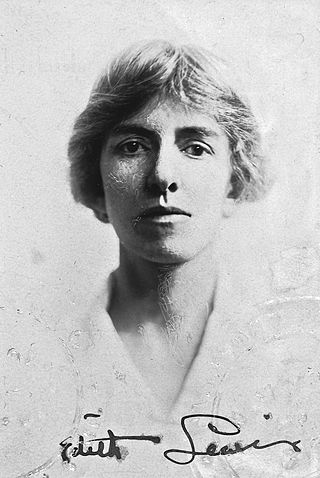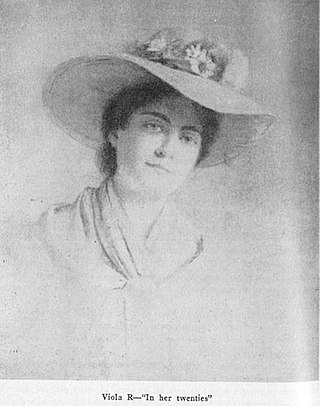Related Research Articles

Willa Sibert Cather was an American writer known for her novels of life on the Great Plains, including O Pioneers!, The Song of the Lark, and My Ántonia. In 1923, she was awarded the Pulitzer Prize for One of Ours, a novel set during World War I.

A Lost Lady is a 1923 novel by American writer Willa Cather. It tells the story of Marian Forrester and her husband, Captain Daniel Forrester, who live in the Western town of Sweet Water along the Transcontinental Railroad. Throughout the story, Marian—a wealthy married socialite—is pursued by a variety of suitors and her social decline mirrors the end of the American frontier. The work had a significant influence on F. Scott Fitzgerald's 1925 novel, The Great Gatsby.

My Ántonia is a novel published in 1918 by American writer Willa Cather, which is considered one of her best works.
"Paul's Case" is a short story by Willa Cather. It was first published in McClure's Magazine in 1905 under the title "Paul's Case: A Study in Temperament", which was later shortened. It also appeared in a collection of Cather's stories, The Troll Garden (1905). For many years "Paul's Case" was the only one of her stories that Cather allowed to be anthologized.

Lucy Gayheart is Willa Cather's eleventh novel. It was published in 1935. The novel revolves round the eponymous character, Lucy Gayheart, a young girl from the fictional town of Haverford, Nebraska, located near the Platte River.
"Nanette: An Aside" is a short story by Willa Cather. It was first published in Courier on 31 July 1897 and one month later in Home Monthly.
"The Bookkeeper's Wife" is a short story by Willa Cather. It was first published in Century in May 1916.
Ardessa is a short story by Willa Cather. It was first published in Century in May 1918.
On the Divide is a short story by Willa Cather. It was first published in Overland Monthly in January 1896.
"The Strategy of the Were-Wolf Dog" is a short story by Willa Cather. It was first published in Home Monthly in December 1896.
The Affair at Grover Station is a short story by Willa Cather. It was first published in Library in June 1900 in two installments, and reprinted in the Lincoln Courier one month later. The story is about a geological student asking an old friend of his about the recent murder of a station agent.
The Namesake is a short story by Willa Cather. It was first published in McClure's in March 1907.
The Garden Lodge is a short story by Willa Cather. It was first published in The Troll Garden in 1905

Marilee Lindemann is an associate professor of English at the University of Maryland, College Park and the director of the LGBT Studies Program. Lindemann received her Ph.D in English from Rutgers University and her B.A. in English and journalism from Indiana University. She has taught at the University of Maryland since 1992. She is a prominent scholar of American writer Willa Cather and is also a well-known blogger, and the editor of a forthcoming scholarly collection engaging with the phenomenon of blogs. She was the 2007 winner of the Modern Language Association's Michael Lynch Service Award. Dr. Lindemann served on the editorial board of American Literature from 2001 to 2003; on the board of managing editors of American Quarterly from 2001 to 2003; and has served on the advisory board of the Cather Archive since 2006. She has received a National Endowment for the Humanities Faculty Graduate Study Program for Historically Black Colleges and Universities Fellowship and a Woodrow Wilson National Fellowship Foundation Research Grant in Women's Studies. A native of Indiana, she lives with her partner of 26 years, Martha Nell Smith, in Takoma Park, Maryland.
Achsah Barlow Brewster was an American painter and writer, and wife of artist Earl Brewster (1878–1957). They are best known today for their close friendship with such prominent figures of the time as D. H. Lawrence, Willa Cather and the Nehru family.

Edith Lewis was a magazine editor at McClure's Magazine, the managing editor of Every Week Magazine, and an advertising copywriter at J. Walter Thompson. Lewis was Willa Cather's domestic partner and was named executor of Cather's literary estate in Cather's will. After Cather's death, Lewis published a memoir of Cather in 1953 titled Willa Cather Living.
Susan Jean Rosowski was a Western American scholar of literature and the works of Willa Cather.
The Elopement of Allen Poole is a short story by Willa Cather, first published in 1893 by The Hesperian while she was a student. The story itself deals with the character of Allen Poole, who is shot by an officer on the night of his elopement with his partner, Nell.
Hard Punishments, also sometimes referred to as Cather's Avignon story, is the final, unpublished, and since lost novel by Willa Cather, almost entirely destroyed following her death in 1947. It is set in medieval Avignon.

Viola Roseboro' was an American literary editor. She was the fiction editor for McClure's and, later, for Collier's, in which role she discovered several important authors. Ida Tarbell called her a "born reader" and a "reader of real genius".
References
- ↑ Gerber, Philip L. (1995). Willa Cather (Rev. ed.). New York: Twayne Publishers. p. 75. ISBN 080574035X.
- ↑ Cather, Willa (2009). Youth and the Bright Medusa: The Willa Cather Scholarly Edition. University of Nebraska Press.
- ↑ Brown, Marion Marsh (1980). Only one point of the compass : Willa Cather in the Northeast (1st ed.). [Danbury, CT]: Archer Editions Press. p. 128. ISBN 0890970173.
- ↑ Burgess, Cheryll (1990). "Cather's Homecomings". Willa Cather : family, community, and history (the BYU symposium). Provo, Utah: Brigham Young University, Humanities Publications Center. p. 52. ISBN 0842522999.
- 1 2 Lee, Hermione (1989). Willa Cather : double lives (1st American ed.). New York: Pantheon Books. p. 372. ISBN 0394537033.
- ↑ Brienzo, Gary (1994). Willa Cather's transforming vision : New France and the American Northeast. Selinsgrove [Pa.]: Susquehanna University Press. p. 95. ISBN 0945636660.
- ↑ Poore, Charles (2003). "The Last Stories of Willa Cather". In Reynolds, Guy (ed.). Willa Cather : critical assessments (2 ed.). Mountfield, East Sussex: Helm Information. p. 60.
- 1 2 3 Bush, Sargent (Spring 1968). ""The Best Years": Willa Cather's Last Story and its Relation to Her Canon". Studies in Short Fiction. 5 (3): 269.
- ↑ Harvey, Sally Peltier (1995). Redefining the American dream : the novels of Willa Cather. Rutherford, N.J.: Fairleigh Dickinson University. p. 3. ISBN 0838635571.
- ↑ Skaggs, Merrill Maguire (2007). "Icons and Willa Cather". Cather Studies. 7.
- ↑ O'Brien, Sharon (1997). Willa Cather : the emerging voice : with a new preface. Cambridge, Mass.: Harvard University Press. p. 85. ISBN 0674953223.
- 1 2 Woods, Lucia (1973). Willa Cather: a pictorial memoir. University of Nebraska Press. p. 102.
- ↑ Murphy, John J. (1982). "Willa Cather and Catholic Themes". Western American Literature. 17 (1): 53. doi:10.1353/wal.1982.0045.
- ↑ Nichols, David K. (December 2012). "Amy A. Kass, Leon R. Kass and Diana Schaub (eds), What So Proudly We Hail: The American Soul in Story Speech and Song: Wilmington, DE: ISI Books, 2011. 790 pp. $35. ISBN: 978–1610170062". Society. 49 (6): 567–570. doi:10.1007/s12115-012-9605-1.
- ↑ Jackson, Joseph Henry (September 22, 1948). "Bookman's Notebook". Los Angeles Times. No. II. p. 5.
- ↑ Bennett, Mildred R.; Rosowski, Susan J. (1984). "Willa Cather Today An Introduction". eat Plains Quarterly. 4 (4): 211–212.
- ↑ Murphy, John J. (2006). "William to Willa, Courtesy of Sarah: Cather, Jewett, and Howellsian Principles". American Literary Realism. 38 (2): 145–159. ISSN 1540-3084.
- ↑ Ugo, Joseph R.; Skaggs, Merrill Maguire, eds. (2007). Violence, the arts, and Willa Cather. Madison: Fairleigh Dickinson University Press. p. 71. ISBN 0838641571.
- ↑ Murphy, John J. (1992). "Willa Cather and the Literature of Christian Mystery". Religion & Literature. 24 (3): 41. ISSN 0888-3769.
- ↑ Romines, Ann (1996). "Her Mortal Enemy's Daughter: Cather and the Writing of Age". Cather Studies. 3.
- ↑ Wagenknecht, Edward (1994). Willa Cather. New York: Continuum. pp. 156–157. ISBN 0826406076.
- ↑ Murphy, John J. (1992). "Willa Cather: A Study of the Short Fiction by Loretta Wasserman". Studies in American Fiction. 20 (1): 124–125. doi:10.1353/saf.1992.0018.
- ↑ Grumbach, Doris (December 1984). "A study of the small room in the professor's house". Women's Studies. 11 (3): 327–346. doi:10.1080/00497878.1984.9978620.
- ↑ Randall, John Herman (1960). The landscape and the looking glass; Willa Cather's search for value. Boston: Houghton Mifflin. p. 357.
- ↑ Thurin, Erik Ingvar (1990). The humanization of Willa Cather : classicism in an American classic. Lund: Lund University Press. p. 357. ISBN 0862382394.
- ↑ Quirk, Tom (1990). Bergson and American culture : the worlds of Willa Cather and Wallace Stevens. Chapel Hill: University of North Carolina Press. p. 179. ISBN 0807818801.
- ↑ Pers, Mona (1976). "Repetition in Willa Cather's Early Writings : Clues to the Development of an Artist". American Studies in Scandinavia. 8 (2): 55–66.
- ↑ Fryer, Judith (1986). Felicitous space : the imaginative structures of Edith Wharton and Willa Cather. Chapel Hill: University of North Carolina Press. p. 249. ISBN 0807841358.
- ↑ Bohlke, L. Brent (1986). Willa Cather in Person: Interviews, Speeches, and Letters. Lincoln & London: University of Nebraska Press. 1909: RED CLOUD.
- ↑ Cather, Willa. "Edwin J. Overing, Jr. (April 30, 1909) | Willa Cather Archive". cather.unl.edu. Retrieved 26 January 2021.
- ↑ March, John (1993). A reader's companion to the fiction of Willa Cather. Westport, Conn.: Greenwood Press. pp. 262–263. ISBN 0313287678.
- ↑ Synnott, Kevin A. (1994). "Defining Community in "Jack-a-Boy"and "The Best Years". Willa Cather Pioneer Memorial Newsletter. XXXVIII (3): 41.
- ↑ BENNETT, MILDRED R. (1982). "THE CHILDHOOD WORLDS OF WILLA CATHER". Great Plains Quarterly. 2 (4): 204–209. ISSN 0275-7664.
- ↑ Kraft, Stephanie (1979). No castles on Main Street : American authors and their homes. Chicago: Rand McNally. p. 98. ISBN 0528818287.
- ↑ O'Brien, Sharon (1984). ""The Thing Not Named": Willa Cather as a Lesbian Writer". Signs. 9 (4): 596. ISSN 0097-9740.